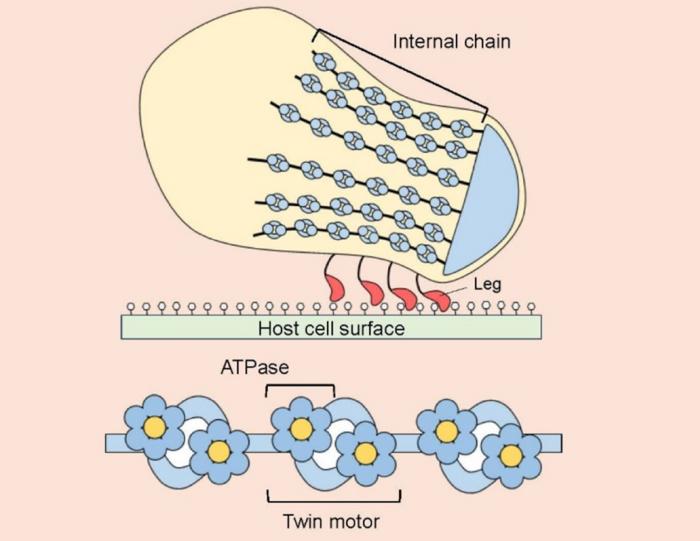In a remarkable breakthrough for microbiology, a research team led by Professor Makoto Miyata at Osaka Metropolitan University has made significant strides in uncovering the complex molecular machinery that enables Mycoplasma mobile to glide. Despite being a member of a class of bacteria that are typically nonmotile, M. mobile, as its name implies, exhibits unique movement capabilities. This finding sheds light on the underlying mechanisms that allow these tiny organisms to propel themselves along surfaces, a phenomenon that remains largely unexplained in the scientific community.
The journey to understanding Mycoplasma mobile’s gliding ability has spanned nearly three decades, with the research team dedicating themselves to elucidating the biological and molecular structures that facilitate this remarkable motility. Utilizing advanced cryo-electron microscopy techniques available at Osaka University, the researchers achieved unprecedented near-atomic resolution imagery of the enzymes involved in the energy conversion processes that underpin gliding. This methodological approach has allowed them to observe the ATPases at work—critical enzymes that harness chemical energy from ATP hydrolysis to drive the gliding mechanisms.
At the core of their findings is the identification of a novel twin motor complex integral to M. mobile’s gliding motion. Interestingly, while the molecular architecture of these motors bears resemblance to known ATP synthases, the researchers have documented that they configure into a yet-unseen structural assembly, suggesting an evolutionary adaptation that highlights the microbial world’s complexity. This unique configuration raises intriguing questions about the evolutionary journey of these enzymes and their adaptation from classical ATP synthase functions to enable locomotion.
Professor Miyata has articulated the broader implications of this research, noting that the revelations surrounding M. mobile’s gliding mechanisms could fundamentally alter our understanding of energy conversion in microbiological systems. He emphasizes that deciphering how ATP hydrolysis translates into motion not only enhances our comprehension of Mycoplasma mobile but also provides a valuable foundation for the development of future biotechnological applications. One such application could be the innovation of nanobot actuators, which may harness similar biological principles for advanced engineering solutions.
In addition to potential technological advancements, the research carries significant implications for the medical field, particularly in combating mycoplasma infections. As pathogens, mycoplasmas are known to cause various diseases, including respiratory infections like pneumonia. Understanding their mechanics and adaptations could lead to the design of targeted treatments that leverage insights gained from these studies, potentially altering the therapeutic landscape for mycoplasma-related illnesses.
While the research has unveiled critical details about M. mobile, it also opens doors for further inquiries into other bacterial species exhibiting unusual motility. This expanding knowledge could provide insights into the evolutionary pressures that shape bacterial adaptation, leading to a better understanding of microbial ecology and the diverse strategies bacteria employ to survive and thrive in various environments.
Moreover, the meticulous nature of this study exemplifies the collaborative spirit of modern scientific endeavors. By integrating different specialties—such as structural biology, microbiology, and advanced imaging technology—the research showcases how interdisciplinary approaches can yield significant discoveries. As the scientific community continues to grapple with the complexities of microbial life, such collaborations will be essential for pioneering new frontiers of knowledge.
Upon reviewing the literature, it becomes evident that this work contributes to a growing body of evidence regarding the diverse motility strategies employed by microorganisms. Bacterial motility, whether through flagella, cilia, or gliding, has profound implications for ecological interactions, pathogenesis, and biotechnological applications. The ongoing exploration of these mechanisms is poised to challenge traditional notions of microbial movement and adaptability.
In conclusion, the work conducted by Professor Miyata and his team is not merely an academic exercise; it is a pivotal step toward rethinking the biology of motility. As scientists continue to unravel the mysteries of Mycoplasma mobile, we stand at the brink of potentially transformative insights that could propel both biomedical research and nanotechnology into new realms of possibility. The intersection of microbiology and engineering represents a fertile ground for innovation, where lessons learned from nature can inform the next generation of technological advancements that address some of humanity’s most pressing challenges.
Subject of Research: Cells
Article Title: Dimeric assembly of F1-like ATPase for the gliding motility of Mycoplasma
News Publication Date: 26-Feb-2025
Web References: DOI link
References: Science Advances
Image Credits: Osaka Metropolitan University
Tags: ATPases and energy conversionbacterial movement capabilitiescryo-electron microscopy techniquesenzyme functions in bacteriagliding bacteria researchmicrobiology breakthroughsmolecular machinery of bacteriamotility mechanisms in microbiologyMycoplasma mobile motilitynovel motor complex in bacteriaOsaka Metropolitan University researchsignificant microbiological discoveries





